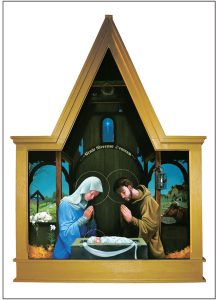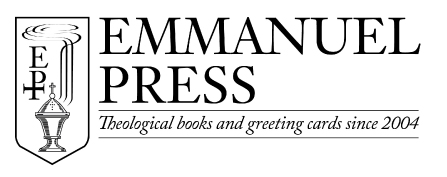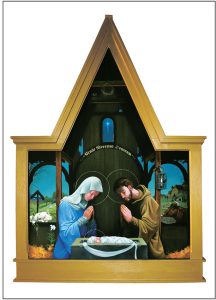Thy Kingdom Come: An Excerpt from Invocabit (1st Sunday in Lent)
“Eve fell by eating. Jesus resisted taking food from the devil in the desert. And He redeems us by feeding. The same action that plunged the world back to near chaos, that which He denied Himself, now unites and reconciles God’s children to God. His body and His blood are better than manna in the desert. Here is balm for your wounds, courage for your fight, peace for your soul, and the strength you need to face temptation. Here is the Word of God written in stone in the flesh of Mary, hidden in bread, that you would not stand against the accuser but would live as God’s own holy child.”
–David H. Petersen, author of Thy Kingdom Come
Thy Kingdom Come: Lent and Easter Sermons by David H. Petersen
 Thy Kingdom Come
Thy Kingdom Come
by David H. Petersen
This collection of sermons arises from the culture of an active parish life as a part of its usual worship routine. With over sixty sermons spanning Pre-Lent, all forty days of Lent, and the Sundays after Easter, this book now serves as an excellent daily devotion for both pastors and parishioners. Distinctive in his preaching style, Pr. Petersen fluidly interweaves the words of Holy Scripture with his own, immersing us in the text and applying Law and Gospel with sharp insight. As Luther explains in his catechisms, preaching the Word brings the kingdom of heaven from Christ, through the Holy Spirit, to the individual, always pointing us to Christ and Him crucified, died, and risen.
“Every one of Pr. Petersen’s sermons is a bloody mess of Law and Gospel. The mess of your sin and the mess of Jesus’ cross are on display in every sermon. No matter the occasion, no matter the readings, every sermon is about Jesus in His saving work, Jesus crucified for you.” -From the Forward, Rev. Todd Wilken
____________________
Rev. David H. Petersen has been pastor at Redeemer Lutheran Church in Fort Wayne, Indiana, since August of 2000. In addition to his pastoral duties, he is also a prolific writer and magazine editor, serving as editor of the Lutheran journal Gottesdienst, for which he writes on the life and liturgy of the Church. Rev. Petersen has been published in many other journals as well—both scholarly and popular—and is much in demand as a speaker and retreat leader. He graduated from Concordia Theological Seminary with a Master of Divinity in 1996.
Symbolism in the Adoremus Christmas Card
When Ed Riojas created “Adoremus” for ArtPrize 2012 in Grand Rapids, he did more than produce a beautiful work of art. He gave us a masterpiece with incredible theological depth, with subtle, intentional allusions to Messianic symbolism. We asked him to describe the symbolism for us, for it is in the details that we find a greater appreciation for the work as a whole.
Starting with the peak of the frame, then moving to the side windows, and finally to the Holy Family:
- Tripartite construction of the stable and its triangular peak, a subtle nod to the Holy Trinity
- The crown of thorns that literally hangs over Jesus’ head
- A laurel wreath entwined with crown of thorns, to show ultimate victory over death
- Two turtle doves (to the left of the crown of thorns), referring to humility and the 8th-day sacrifice
- The eight-pointed Bethlehem star which announces Christ’s birth but also alludes to His death by its cross shape
- The crucifix in a road-side shrine
- A ram caught in a thicket, just as Abraham’s substitute sacrifice was given to him
- The Rose of Sharon blooming, as the Messiah is now revealed
- The ram and bull are untouched, for now is come down the ultimate sacrifice
- The inn with smoke intentionally excluded from the chimney, showing a lack of hospitality
- The open tomb in front of the inn
- Circular halos, or nimbii, showing figures to be among the saints
- Mary’s blue and white clothing, traditional colors that point to her virginity (purity)
- The lily, which is a symbol of the Virgin Mary
- The draw knife (carpenter’s tool), symbol for Joseph
- The lantern next to the draw knife with a single burning light, representing Christ as the light of the world
- Jesus, the “sign” (Luke 2:12), wrapped in swaddling cloths (in a similar way as a body for burial) and lying in a manger (a typical stone manger of the Middle East, similar to a sarcophagus)
- The Latin included in the piece (Venite Adoremus Dominum) is reflected in the card’s inside text: Word of the Father Now in flesh appearing. O come, let us adore Him.
Find Adoremus and our other Christmas cards here.
Pr. David Petersen, on thanksgiving
“We pray for daily bread not to remind God that we need it, but that He would lead us to realize that He is the giver and that we would receive it with thanksgiving. That word ‘thanksgiving’ happens to be the English translation of the Greek word ‘eucharist.’ Apart from the death and resurrection of Jesus Christ, there would be no mercy and no providence, no bread for hungry people. It is only because the Father has reconciled us to Himself in the Son and declared us righteous that He loves us and that anyone, believer or not, has anything close to what is necessary for this body and life.”
____________
Pr. David H. Petersen — excerpt from his sermon on Laetare (John 6:1-15), included in his upcoming sermon book.
New Download: Solid Declaration Readings According to the Church Year
Just in time for the beginning of the church year on Advent 1, we are pleased to offer a new free download of Solid Declaration readings for major feasts and Sundays of the one-year series. Reading the Lutheran Confessions is important to both pastor and parishioner. When done weekly, it is a helpful and salutary discipline. Pr. Craig Meissner of Immanuel Lutheran Church, U.A.C., Steger, Illinois, has provided the following reading schedule, linking sections of the Solid Declaration to the church year themes in the historic one-year series.
*Find it in our Downloads tab or click here to go directly to the pdf
_________________________
Pr. Meissner writes:
The Solid Declaration is a document of utmost importance for confessional Lutherans. Like other books contained in the Book of Concord, it teaches key distinctions and doctrines essential for understanding and abiding in the true faith in the face of errors that American Lutherans still confront today. The Solid Declaration usually does this with less-detailed discussions of people, places, histories, etc., of those involved in the various controversies compared to other confessional documents, except the creeds and catechisms. Parishioners may therefore find these selections less cumbersome, though still very much edifying, making it appropriate for printing in a church bulletin or newsletter and perhaps inspiring further study of the Lutheran Confessions.
The vast majority of the Solid Declaration is covered in this reading schedule. My goal was to apply nearly all of the Solid Declaration to each of the church year Sundays and most major festivals commonly observed in our congregations. Keeping in mind the limited space of church bulletins and newsletters, I omitted only those paragraphs where a controversy or heretical position was introduced without a sufficient conclusion or rebuttal as well as those that contained extraneous personal or local details.
Some days of the church year have multiple options from the Solid Declaration provided; others have just one. You will note that the selections tend to be shorter during the “school year” and longer in the Trinity season, when there would likely be more space in a church bulletin. The pastor may alter these as he deems fit. One more suggestion before beginning this exercise: the pastor may wish to first present “The Comprehensive Summary, Foundation, Rule, and Norm” as an introduction to the readings.
May this chart be a useful and edifying tool for you and those you serve in the Lord’s Name.
Pr. Craig Meissner, S.T.M.
Immanuel Lutheran Church, U.A.C., Steger, Illinois
New Christmas Cards with Art by Edward Riojas are Now Available!
Since the debut of our first Christmas cards almost one year ago, we have been pleased and humbled by the fantastic response to cards which combine beautiful, unique works of art with a clear confession of our Savior’s birth.
This year we are thrilled to offer two new Christmas cards with artwork by Edward Riojas, an artist whose work is also included in The Brotherhood Prayer Book and on several of our greeting cards and book covers. His sacred work can also be found in private collections and sanctuaries throughout the U.S. and Canada and in numerous Lutheran publications.
The first card, Adoremus, features a seven foot tall oil painting on wood originally created as an entry for ArtPrize 2012. There is much symbolism in the details: the lily, which is a symbol of the Virgin Mary; the carpenter’s tool next to the lantern with a single burning light, representing Christ as the Light of the world; the eight-pointed Bethlehem star which announces Christ’s birth but also alludes to His death by its cross shape; the crown of thorns that literally hangs over Jesus’ head; and the inn with smoke intentionally excluded from the chimney, showing a lack of hospitality. The inside text reflects the Latin included in the piece (Venite Adoremus Dominum): Word of the Father Now in flesh appearing. O come, let us adore Him.
The second card, Virgin and Child, features an oil painting on wood in the artist’s personal collection. Riojas used his daughter as a model for the Virgin Mary, depicting the solemn and holy night of our Lord’s birth. The inside text proclaims Isaiah’s words of prophesy: For to us a child is born, to us a Son is given…and his name shall be called Wonderful Counselor, Mighty God, Everlasting Father, Prince of Peace.
Like our other Christmas cards, these cards are 5″ x 7″ with classic gold foil-lined envelopes. Also be sure to take a look at our other ecclesiastical greeting cards, including gorgeous fresco and stained glass cards as well as Baptism, Easter, and other Christmas cards.
Art as Confession: Student from Saudi Arabia learns about Christ through Riojas’ Adoremus
 “‘Adoremus’ is hanging in the barn. After spending seemingly endless hours painting it, hauling it to ArtPrize, babysitting it for the duration, hauling it back home and not selling it, one would think the labor of my hands was not blessed.
“‘Adoremus’ is hanging in the barn. After spending seemingly endless hours painting it, hauling it to ArtPrize, babysitting it for the duration, hauling it back home and not selling it, one would think the labor of my hands was not blessed.
But there was that one college student assigned to ask questions of the ArtPrize artists. He chose to ask me questions, because I was standing there by my piece. I began explaining the symbolism and its deeper meaning, and ended by explaining the very basics, which we too often take for granted.
I will never know what happened to that young man. I do know he could be killed for asking the questions which weren’t part of his assignment; for asking why the man in my painting had to die; for asking how they killed this man. That student was an exchange student from Saudi Arabia, and he had never heard of Jesus Christ.
Being reminded that the work of my hands is a blessing sometimes comes in very profound ways. I pray that it will continue to be so blessed.”
-excerpted from Ed Riojas’ Facebook page, originally posted October 28, 2012
Seed-Grains of Prayer: Sunday Evening Prayer
“I render thanks unto Thee, O true and everlasting Light, that Thou hast this day protected me by Thy light and Spirit against every grievous sin. And now, during the night which Thou hast ordained for the rest of my poor body, O Lord, grant unto my weary soul to find rest and peace in Thee against all the wiles and onslaughts of the evil one. Cause my mind and my thoughts, together with my hands and my feet, to glorify Thee and be silent before Thee, Who art present and mindful of Thine own, when deep slumbers embrace them. O, let not this wicked flesh overmaster my poor soul, lest I forget Thee in the night watches. Into Thy hands I commit my spirit, O gentle Shepherd, into Thy faithful hands. Thou hast redeemed my soul, O Lord God, most faithful; permit me not to fall away from Thee. Watch by me and cover me with the protection of Thy wings. When the night is past, awaken me and grant me the light by which I may walk and dwell safely with Thee in yonder eternity. Hear my prayer and answer me, O Thou Who slumberest not nor sleepest; through Jesus Christ. Amen.”
Wilhelm Loehe, Seed-Grains of Prayer, #103.
Pr. David Petersen on Matthew 25:31-46
“When did you ever do anything? Change the question. Do not be afraid. Look up and ask, ‘When did Christ do something?’ That is the question that leads to life. Don’t look to your works. Look to His. The Christ went to trial and was condemned by Pilate. The ironic title ‘King of the Jews’ was placed over His head, ironic because it was a false charge, but completely true. There He paid for sins that He did not commit, and which we don’t even remember, and now even He has forgotten them. He has been condemned and has died that you might get credit for works you did not perform. Turn from ‘When did we fail?’ to ‘When, O Lord, did you serve us?’ And then, ‘Where, O Lord, do you serve us?’ For He lives. And He serves in His Word and Holy Supper.”
______________
Pr. David H. Petersen — an excerpt from his sermon on Monday of Invocabit (Matt. 25:31-46), included in his upcoming sermon book
Update on Future Projects: Books and Cards
As we mentioned several weeks ago, we are putting the final touches on two new Christmas cards with art by Edward Riojas. These cards will be available for sale in mid-November.
Do you or your organization send out a lot of Christmas cards? We have had multiple requests for bulk orders, so we have decided to offer a limited-time bulk discount with a minimum order of 200 cards. You’ll receive 10% off of 200-299 cards; 15% off 300-399 cards, 20% off 400-499 cards, and 25% off 500+ cards. The order can be a mix of any of our four Christmas cards, combining them in sets of 10. However, bulk orders will need to be placed by October 31 in order to get these prices. Contact us for a customized invoice.
We are also excited to announce a book of Lent and Easter sermons by Rev. David Petersen of Redeemer Lutheran Church in Fort Wayne, including more than 60 sermons for the Sundays of pre-Lent, all 40 days of Lent, the Sundays after Easter, as well as saints days in TLH and LSB that fall within the season. The Sunday sermons are based on the Gospel readings from the historic one-year lectionary while the propers for the 40 sermons of Lent come from Daily Divine Service Book, edited by Rev. Heath R. Curtis. It will be an excellent resource for Lenten daily devotions for both pastors and parishioners. The projected release date for this book is late December/early January.
Also forthcoming is an updated reprint of Ceremony and Celebration by Paul H.D. Lang. This book is an invaluable resource in explaining the ceremonial of Lutheran liturgy: “Ritual refers to that part of a divine service which consists of its words, that is, the rite or the order of service…Ceremonial is everything connected with the performance of a rite. It refers not only to bodily expressions, such as speaking, singing, kneeling, bowing, making the sign of the cross, and the outward observance of the church year, but also to the ornaments, symbols, and material objects employed in the church’s worship, for example, the church building, the altar, crucifixes, candles, and vestments. Ceremonies are solemn religious things and actions. All these are, as stated, included in the term ceremonial” (Lang, Ch. 2). We plan to have this book available in early January, just in time for the Symposia at Concordia Theological Seminary here in Fort Wayne.
We will definitely post updates here and continue to send out occasional emails, but we also keep our Facebook page updated more frequently so as not to inundate you with emails along the way. You can follow us on Facebook by clicking on “Like” at the top right-hand of this page.




